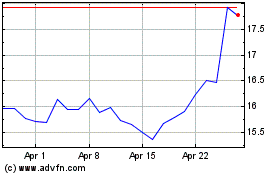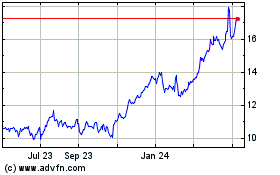By Akane Otani, Riva Gold and Aaron Kuriloff
U.S. stocks rallied Thursday to end a tempestuous first half of
the year.
Three days of gains chipped away at the losses that followed the
U.K.'s vote to exit from the European Union, leaving the Dow Jones
Industrial Average 81 points below where it was last Thursday,
before the referendum results, and up 2.9% for the year.
The tumult at the end of the second quarter echoed how markets
began the first.
Stocks and oil prices had dropped together in the first six
weeks of 2016, as investors worried that slowing economic growth in
China could ripple world-wide and even tip the U.S. into recession.
As those concerns eased and the Federal Reserve held back on
raising interest rates, risk assets rebounded, sending the Dow
industrials and the S&P 500 back into positive territory for
the year and near records.
Stocks around the world sold off sharply after the U.K. vote, as
concerns mounted about a range of political and economic
uncertainties that could weigh on growth and investment. Currency
markets had their most volatile day in modern history, according to
Bank of America Merrill Lynch.
After taking a hit from Brexit, the S&P 500 index is up 2.7%
for the year. The tech-heavy Nasdaq Composite Index hasn't been in
positive territory this year and is down 3.3%. The Nasdaq notched a
gain in 2015, while the S&P 500 and the Dow fell slightly.
Stock markets in Europe and Asia haven't fared as well as the
U.S. this year. The Stoxx Europe 600 is down 9.8% in 2016, and
Japan's Nikkei Stock Average has fallen 18%.
U.S. oil prices have rebounded 84% since this year's low in
mid-February on supply disruptions and expectations of falling
production. Even with those gains, however, oil prices are still
well off their 2008 highs, and energy shares remain below where
they were a year ago. Oil fell 3.1% Thursday to $48.33 a
barrel.
Some investors said the broader stock market will need fresh
signs of health in the U.S. economy and new growth in corporate
earnings to push much higher.
"We've been in a period where the big picture has been the
focus," said Paul Quinsee, chief investment officer of U.S. equity
at J.P. Morgan Asset Management, which manages about $1.7 trillion.
"Now we're moving into a few weeks where investors will turn their
attention back to corporate profits."
While stocks have broadly made up some ground after the U.K.
vote, the impact on currency markets and government-bond yields has
remained pronounced.
Yields on safe government debt have fallen to record lows around
the world after Brexit. The 10-year German government bond, or
bund, yielded minus-0.048% Thursday, according to Tradeweb.
Ten-year U.S. Treasury yields are still near multiyear lows, at
1.492%, compared with 2.273% on Dec. 31. Yields move inversely to
prices.
The yield on 10-year U.K. government bonds, or gilts, touched an
all-time low of 0.851% Thursday, after Bank of England Gov. Mark
Carney predicted that the central bank would need to cut its key
interest rate over the summer.
Investors have been expecting a policy response in the wake of
the U.K.'s vote to leave the EU, including further stimulus from
the European Central Bank.
Mr. Carney said an initial assessment of the economic impact
from the referendum result would be made at the bank's July
meeting.
On Thursday, the Dow industrials rose 235.31 points, or 1.3%, to
17929.99. The S&P 500 gained 28.09 points, or 1.4%, to 2098.86.
The Nasdaq Composite added 63.43 points, or 1.3%, to 4842.67.
The British pound dropped 0.9% against the dollar to $1.3311.
The currency has lost 9.7% so far this year, with June marking its
biggest monthly decline since 2008.
Meanwhile, Japan's yen has kept strengthening this year as
investors sought havens. The dollar is down 14% against the yen so
far this year.
Gold is up 24% for the year so far, at $1,318.40 an ounce, after
its best two-quarter gain since the end of 2007.
Some analysts expressed concerns that much of the gains in the
stock market have been driven by investors piling into safer
shares, rather than stocks broadly. That could be a sign that the
appetite for risk hasn't yet returned.
The S&P 500 utilities sector, which has attracted investors
looking for steady, bondlike stocks, is up 21% so far this year.
Riskier sectors, such as technology and financials, are still down
in 2016.
"The real sign that we're moving forward will be the unwinding
of that trade" over an extended period of time, said Art Hogan,
chief market strategist at Wunderlich Securities.
Write to Riva Gold at riva.gold@wsj.com and Aaron Kuriloff at
aaron.kuriloff@wsj.com
(END) Dow Jones Newswires
July 01, 2016 02:47 ET (06:47 GMT)
Copyright (c) 2016 Dow Jones & Company, Inc.
Deutsche Bank Aktiengese... (NYSE:DB)
Historical Stock Chart
From Mar 2024 to Apr 2024

Deutsche Bank Aktiengese... (NYSE:DB)
Historical Stock Chart
From Apr 2023 to Apr 2024
